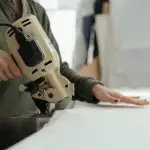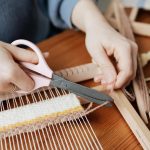Looking to master the art of fabric cutting? Did you know that using the right scissors can increase your cutting efficiency by up to 50%?
When it comes to selecting the best scissors for fabric cutting, the options can be overwhelming. It's essential to consider the type of fabric you'll be cutting and the features that will enhance your cutting experience.
Understanding the different blade types, ergonomic considerations, and specialized features will empower you to make an informed choice.
With proper maintenance and care, your fabric scissors can become your most trusted tool.
Let's delve into the world of fabric scissors and uncover the key factors that will lead you to mastery in fabric cutting.
Key Takeaways
- Different types of fabric scissors are available, including left-handed options and pinking shears for specific uses.
- Consider the blade material, cutting angles, and sharpening techniques when choosing fabric scissors.
- Ergonomic considerations, such as handle design and weight balance, can greatly improve the cutting experience.
- Look for specialized features like high-quality blades, ergonomic handles, and left-handed options to enhance precision and maneuverability.
Types of Fabric Scissors
When choosing fabric scissors, you should consider the various types available to ensure you have the right tool for the specific fabric you're cutting. For left-handed individuals, it's crucial to look for left-handed options to ensure comfort and precision. Left-handed fabric scissors are designed with the blades and handles switched to accommodate the dominant left hand, making the cutting process much smoother and more efficient.
Another type of fabric scissors that serves a specific purpose is pinking shears. These scissors have a serrated edge that creates a zigzag pattern along the fabric's edge, which helps in preventing fraying. They're particularly useful for fabrics that tend to unravel, such as woven materials. Pinking shears are a valuable addition to your sewing kit, especially when working with delicate fabrics like silk and satin.
Understanding the different types of fabric scissors and their specific uses is essential for mastering the art of fabric cutting. Whether it's investing in left-handed options for comfort or utilizing pinking shears to prevent fraying, having the right tools can significantly impact the quality of your fabric cutting endeavors.
Choosing the Right Blade
To choose the right blade for fabric cutting, consider the specific material you'll be working with and the type of cut you want to achieve. Different fabrics require different blade types and cutting angles to achieve clean, precise cuts. Here are three key factors to consider when choosing the right blade for fabric cutting:
- Blade Material: The type of fabric you're cutting will determine the ideal blade material. For general fabric cutting, stainless steel blades are a popular choice due to their durability and resistance to corrosion. For more delicate fabrics such as silk or chiffon, consider blades made of high carbon steel, which can provide a sharper edge for cleaner cuts.
- Cutting Angles: The cutting angle of the blade plays a crucial role in achieving the desired cut. For straight cuts, a blade with a finer angle, such as 30 degrees, is suitable. However, for more intricate or curved cuts, a blade with a wider angle, such as 60 degrees, can provide better maneuverability.
- Sharpening Techniques: Regardless of the blade material, it's essential to maintain its sharpness for optimal cutting performance. Explore sharpening techniques such as using a sharpening stone or professional sharpening services to keep your fabric cutting blade in top condition.
Ergonomic Considerations
Considering your comfort and ease of use when cutting fabric, ergonomic considerations play a crucial role in determining the most suitable scissors for your needs.
Handle design is a key aspect of ergonomic consideration when choosing fabric scissors. An ergonomic handle design can significantly reduce hand fatigue and discomfort, allowing you to work on your projects for longer periods without experiencing strain. Look for scissors with handles that are designed to fit the natural grip of your hand, providing support and comfort during extended cutting sessions. Some scissors feature cushioned or padded handles that can further enhance the ergonomic benefits, offering a soft and comfortable grip that minimizes pressure on your fingers and palm.
Additionally, consider the weight and balance of the scissors, as these factors can also impact your comfort and ease of use. Finding a pair of fabric scissors with an ergonomic handle design and a balanced weight distribution can make a noticeable difference in reducing hand fatigue and improving your cutting experience.
When selecting scissors, prioritize ergonomic features to ensure a comfortable and enjoyable fabric cutting process.
Specialized Features to Look For
For fabric cutting, look for scissors with specialized features that enhance precision and control. When selecting scissors for fabric cutting, it's essential to consider specialized features that can greatly improve your cutting experience. Here are some key features to look for:
- Blade Material: Opt for scissors with blades made from high-quality stainless steel or titanium. These materials are durable, resistant to corrosion, and maintain sharpness for extended periods, ensuring clean and precise cuts.
- Handle Design: Look for scissors with ergonomic handles that provide a comfortable grip and reduce hand fatigue during prolonged cutting sessions. Handles with soft, cushioned inserts can also help absorb pressure, offering added comfort and control.
- Left-Handed Options for Precision Cutting: If you're left-handed, consider scissors specifically designed to accommodate left-handed users. These scissors are engineered with blade angles and handle designs that cater to the unique cutting orientation of left-handed individuals, allowing for enhanced precision and maneuverability.
Maintenance and Care
Ensure proper maintenance and care of your fabric-cutting scissors to prolong their lifespan and maintain optimal cutting performance. Preventive measures are essential to keep your scissors in top condition. After each use, wipe the blades with a clean, dry cloth to remove any fabric residue and prevent corrosion. Apply a light coat of oil to the blades to prevent rust and keep them moving smoothly. Regularly check the tension of the scissors and adjust it as needed to ensure precise cutting. Additionally, avoid using fabric-cutting scissors for anything other than fabric to maintain their sharpness.
Proper storage solutions are also crucial in maintaining the quality of your fabric-cutting scissors. Store them in a dry environment to prevent rust and corrosion. Consider using a blade guard or sheath to protect the blades when the scissors aren't in use. Furthermore, keep them in a designated place to avoid damage or accidental misuse.
Frequently Asked Questions
Can Regular Household Scissors Be Used for Cutting Fabric?
Yes, regular household scissors can be used for cutting fabric, but using fabric scissors or shears designed for fabric cutting is recommended for better precision and to prevent fabric fraying, especially for delicate or thick fabrics.
What Is the Best Way to Sharpen Fabric Scissors at Home?
To DIY sharpen fabric scissors at home, use a sharpening stone or sandpaper for minor nicks. For professional sharpening services, consider sending your fabric scissors to a specialized sharpener. Regular maintenance ensures precise fabric cutting.
Are Left-Handed Fabric Scissors Different From Right-Handed Ones?
Left-handed fabric scissors are designed with an ergonomic grip for better control and less hand fatigue. This allows for precise fabric cutting techniques. The difference in design caters to left-handed individuals, enhancing their cutting experience.
Can Fabric Scissors Be Used for Cutting Other Materials Like Paper or Cardboard?
Yes, fabric scissors can be used for cutting other materials like paper or cardboard, but it's best to use metal scissors for fabric cutting as they are more durable and provide sharper cuts compared to plastic ones. When comparing fabric scissors and rotary cutters, fabric scissors offer more precision, especially for intricate patterns, whereas rotary cutters are efficient for long, straight cuts.
How Do I Know When It's Time to Replace My Fabric Scissors?
When it's time to replace your fabric scissors, signs like dull blades or difficulty cutting through fabric indicate the need. Regular maintenance and proper care can help prolong their life, but eventually, replacement is necessary for precise fabric cutting.
- Innovations in Moisture-Wicking Textiles - July 18, 2024
- Engineering Fabrics for Optimal Performance - July 18, 2024
- The Science of Breathability in Fabrics - July 18, 2024







